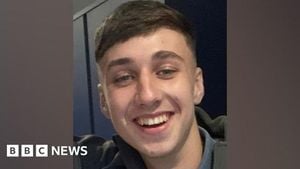The tragic crash of Air India Flight 171 on June 12, 2025, which claimed 260 lives, continues to be a focal point of intense investigation and emotional turmoil within the aviation industry. Despite preliminary reports highlighting fuel control switch manipulation as a critical factor, the U.S. Federal Aviation Administration (FAA) and the National Transportation Safety Board (NTSB) have expressed strong confidence that no mechanical malfunction or inadvertent movement of these switches caused the disaster.
FAA Administrator Bryan Bedford spoke at the Oshkosh Air Show in Wisconsin on July 24, 2025, addressing the swirling questions around the Boeing 787 Dreamliner’s fuel control unit. "We can say with a high level of confidence it doesn’t appear to be a mechanical issue with the Boeing fuel control unit," Bedford told reporters, according to Reuters. He further emphasized, "We feel very comfortable that this isn’t an issue with inadvertent manipulation of fuel control." His remarks came after extensive inspections and testing of the fuel control switches on active aircraft, including those in Air India’s fleet.
The focus on the fuel control switches stems from the preliminary report released earlier in July by India's Aircraft Accident Investigation Bureau (AAIB), which revealed that both fuel switches were moved from the "Run" to the "Cutoff" position shortly after takeoff. This action cut fuel supply to the engines, causing them to shut down mid-climb. The cockpit voice recorder captured a tense exchange between the pilots, with First Officer Clive Kunder questioning Captain Sumeet Sabharwal about the fuel cutoff, to which Sabharwal responded he did not perform the action.
According to the AAIB report, the switches were then reversed, and the engines began to come back online, but tragically, the aircraft crashed into a medical college campus in Ahmedabad, India, killing all but one of the 242 passengers aboard and 19 people on the ground. The report also referenced a 2018 FAA advisory urging airlines to inspect the locking mechanisms on these fuel switches to prevent accidental movement, a recommendation Air India had not implemented prior to the crash. However, subsequent inspections of all Boeing 787s and 777s in Air India’s fleet found no issues with the locking systems.
The investigation, jointly led by the AAIB and NTSB, has not concluded the cause of the switches’ movement, leaving open the question of whether it was manual or due to some other factor. Aviation expert Captain Kishore Chinta, a former air accident investigator, has publicly questioned the timeline and actions taken during the crucial 10 seconds after takeoff. He noted inconsistencies in the timestamps recorded, stating, "The timestamps just don't match up. And if it took one second to put out both the switches quickly, why did it take four seconds to put them back on?" He emphasized that everything significant happened within the first 10 seconds of lift-off.
Chinta also cautioned against jumping to conclusions about pilot culpability. "We're doing gross injustice to the pilots who are not there to defend themselves by guestimating and coming up with theories which are mere assumptions," he said during an interview with Piers Morgan on his YouTube show, Uncensored. He highlighted that the key to the mystery might lie in whether the fuel switches could be moved by any means other than manual intervention, a detail not clarified in the preliminary report.
Despite some speculation from internet commentators suggesting pilot involvement, many colleagues and friends of Captain Sabharwal have defended his character, describing him as a "gentle soul" and an "ace pilot" with over 8,200 flight hours. Sabharwal had reportedly been struggling with personal grief following the death of his mother in 2022 and had taken bereavement leave, but was medically cleared to fly before the accident. His peers remember him as humble and safety-conscious, with no prior incidents to his name.
The psychological impact of the crash on Air India’s flight crew has been profound. Following the incident, sick leave among pilots surged dramatically, with 112 pilots—51 commanders and 61 first officers—reporting unfit for duty on June 16 alone. The crash has deeply shaken morale, particularly among those operating Boeing 787 aircraft, with many pilots expressing anxiety and distress over the unresolved cause of the accident. Some have voiced concerns over the preliminary report’s suggestion of pilot suicide, a theory they strongly reject.
In response to this crisis, India’s Directorate General of Civil Aviation (DGCA) has mandated mental health initiatives across all Indian carriers, including Air India and IndiGo. These measures include rapid psychological assessments during mandatory medical exams, specialized training for flight crews and air traffic controllers to recognize and manage mental health issues, and the activation of Peer Support Programmes (PSPs). These confidential, non-punitive programs aim to provide aviation professionals with a safe space to discuss stress and anxiety, a critical step given the high-pressure nature of their work.
FAA officials have also taken proactive steps, issuing a continued airworthiness notification on July 11, 2025, to all Boeing operators worldwide, reinforcing the importance of fuel switch inspections. Air India promptly completed these inspections on its Boeing 787 and 777 fleets, finding no mechanical faults.
The crash remains one of the deadliest aviation disasters in recent years, prompting calls for greater transparency and thoroughness in the investigation. Aviation safety advocates urge a comprehensive review of all systems before attributing blame, as Ed Pierson, Executive Director of the Foundation for Aviation Safety and a former Boeing employee, told Piers Morgan, "There's a lot of things that need to be examined here, systems wise, before we again jump to the conclusion that this was a pilot making a mistake or even intentionally."
As the investigation progresses, families of the victims and the aviation community await definitive answers. The tragedy has not only highlighted technical and procedural concerns but also underscored the human toll on those who operate the skies. With both mechanical and human factors under scrutiny, the final report will be crucial in shaping future safety protocols and restoring trust in the aviation industry.





